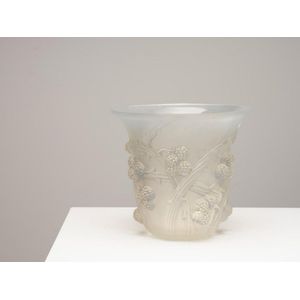Opalescent Blackberry Vase by Rene Lalique
Rene Lalique, Mures (Blackberries), Phosphate opal glass, mould-blown using four part-mould, acid-etched. opalescent flared vase with raised blackberry plant and fruit motif. R. Lalique France acid-etched to base. Model created on 9th October 1930, not continued after 1947. Height 19 cm, diameter 20.5 cm
You must be a subscriber, and be logged in to view price and dealer details.
Subscribe Now to view actual auction price for this item
When you subscribe, you have the option of setting the currency in which to display prices to $Au, $US, $NZ or Stg.
This item has been sold, and the description, image and price are for reference purposes only.
- Opal Glass - Opal glass, also known as milk glass, is a type of opaque glass that is usually white or cream-colored, with a slightly translucent appearance resembling opal. It is produced by adding various materials to the glass during the manufacturing process, such as tin, fluorides, or phosphates, which give it its characteristic milky appearance.
Opal glass has been used for centuries in the production of decorative objects, such as vases, lamps, lamp shades and figurines. It was particularly popular in the 19th century in Europe, where was used by glass makers such as Lalique.
Opal glass is still used today in the production of a wide range of decorative and functional objects, including lampshades, jewelry, and kitchenware. Its milky appearance gives it a timeless, elegant look that is popular with collectors and enthusiasts of antique and vintage glassware. - Opalescent / Opaline - The descriptions of glass as "opalescent" or "opaline" are often used interchangeably by dealers and auction houses. At the upper end of the scale, opalescent / opaline glass can refer to the opal-like milky blue glass produced by Lalique and Etling. It also refers to the pressed glass mass produced in Britain from the 1840s with a milky white edge as sugar-basins, milk jugs and vases were made in great quantities for the mass market, and were sold at fairs along with Staffordshire figures and wooden dolls. A less common type of opalescent glass was made from two layers of glass blown into a mould.
This item has been included into following indexes:
-
Lalique (France), item types
- other items 1,054
- vases 536
- Lalique (France), patterns, vases - Mures 2
